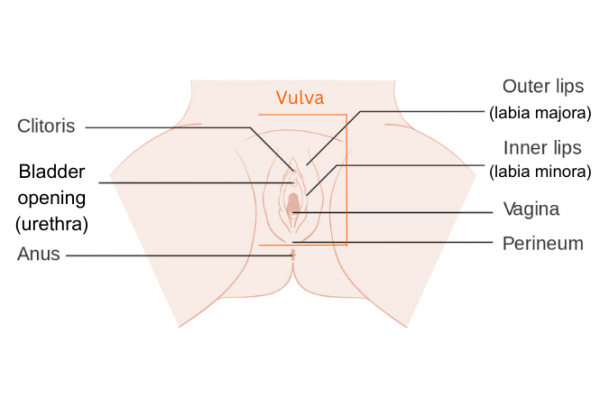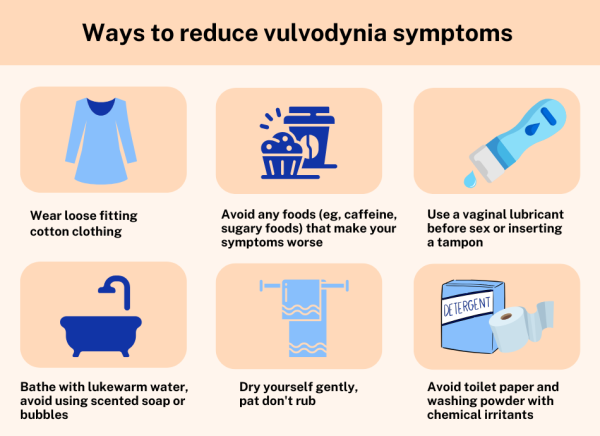Vulvodynia
Sounds like ‘vul-vo-din-ia’
Key points about vulvodynia
- Your vulva is the external genital area around the entrance to your vagina.
- Vulvodynia is pain or discomfort of your vulva lasting at least 3 months.
- The cause is unknown but it's probably linked to your body's nerves, hormones or immune system.
- It can be embarrassing to talk about but is quite common, about 16 in every 100 women are affected at some point.
- It's important to talk to your healthcare provider as treatment can help you manage your pain and live a normal life.

Vulvodynia is pain and discomfort of the vulva occurring for at least 3 months. The cause is unknown, but it's likely that factors relating to the body's nerves, hormones or immune system are involved.
The pain may be limited to only specific areas of the vulva, or it may involve the entire vulval area. The pain may be caused by a specific activity, may occur at random, or be a mixture of the two.
The image below shows the parts of your anatomy included in the vulva.

Image credit: Wikimedia Commons
While vulvodynia is not specifically caused by infection, skin disease or cancer, it's possible there may be a previous history of infection, inflammation, or irritation. If you're worried about any symptoms it's important that you see your healthcare provider for an assessment. Vulvodynia is only diagnosed when other issues have been ruled out.
Vulvodynia can be very uncomfortable and women are often embarrassed to seek help. It's quite common, affecting about 16 in every 100 women at some point in their life. It's important to talk to your healthcare provider about your symptoms; treatment can help you manage the pain better and lead a full and active life.
The pain and discomfort around the vulva may be described as:
- burning
- stinging
- rawness
- itching
- soreness
- throbbing
- swelling.
The symptoms may occur at different times for different women and can have a significant impact on your quality of life.
Symptoms may:
- be constant or come and go for months or even years
- be mild or very bad
- be felt during and after sex
- flare up when you sit on a bicycle, put in a tampon, wear snug underwear or wipe your vulva.
The pain may occur while sitting or resting and may not be related to touch or pressure.
Pain in your vulva isn't always vulvodynia. It can have a number of other causes, such as:
- persistent vaginal thrush or other vaginal infections
- sensitivity to something touching the vulva, such as soap, bubble bath or medicated creams (known as irritant contact dermatitis)
- a drop in the hormone oestrogen causing dryness of the vulva, particularly during the menopause
- a recurrent herpes infection
- vulval cancer – skin changes may be an indication.
Your healthcare provider will want to rule out these conditions before treating you for vulvodynia. Some people can have a combination of problems, for example recurrent thrush and vulvodynia, with both needing proper treatment to reduce pain.
The exact cause of vulvodynia is not known. Many factors acting together may be involved. Some of these factors are:
- Damage or irritation of the nerves of the vulva.
- An increased number of nerve endings to some parts of the vulva.
- Increased production of chemicals by cells in the vulva that lead to inflammation (redness and swelling).
- Long-term reactions to certain chemicals.
- Changes in responses to hormones.
- Pelvic floor muscle dysfunction.
- Sensitivity to certain foods.
- Factors relating to relationships, mood, coping strategies, sexual function.
- Other pain syndromes, eg, painful bladder syndrome, fibromyalgia or irritable bowel syndrome (IBS).
There is no special test for vulvodynia, only tests to prove the pain is not caused by other conditions. Your healthcare provider will usually do a physical exam and may take and test swabs of your vagina and vulva to rule out other irritations such as thrush or eczema.
There are many treatments for vulvodynia, but what works for someone else may not help you. Work with your doctor to find what is best for you. Even though there is no cure, treatment can help you feel better and lead a full and active life. Vulvodynia goes away on its own in about 40% of women.
Self-care
Here are a few things you can try to help relieve immediate pain and soreness:
- To relieve itching and pain, apply a cold water compress or cool gel packs to the vulva. Don't scratch the area.
- For pain when sitting, using a doughnut-shaped cushion can help.
- Vaginal lubricants may soothe the area and help moisturise the vulva. Talk to your pharmacist about a suitable product.
Here are a few lifestyle tips may help reduce symptoms of vulvodynia:
- Bathing
- Avoid scented soaps, shower gels, bubble bath, vaginal sprays or douches, as these can irritate your skin. Instead of scented soap or shower gel, rinse with water only or use an emollient as a soap substitute. Read more about wash-off emollients as soap substitutes.
- Avoid hot baths or showers – use lukewarm water instead.
- Gently pat the area dry. Don't rub harshly with a towel.
- Some toilet papers and washing powders may have chemicals in them that can also irritate the skin.
- Wear loose-fitting cotton clothes. Avoid nylon and other fabrics that hold moisture close to the skin. This may cause irritation and allow an infection to start.
- Try using a vaginal lubricant such as Sylk® before intercourse or before inserting a tampon. When choosing a vaginal lubricant, avoid those with alcohol or preservatives. Avoid using KY Jelly.
- Stay active, but limit exercises that can irritate the vulva, such as bike riding or horseback riding. Use petroleum jelly before swimming to provide protection from chlorine.
- For some women, certain foods make symptoms worse (eg, caffeine, foods high in sugar, acidic foods and processed foods). If you suspect that some foods may be triggering your symptoms, cut out one food at a time and make a note of your symptoms.

Image credit: Healthify He Puna Waiora, NZ
Physiotherapy
Pelvic floor exercises (such as squeezing and releasing your pelvic floor muscles) to help relax the muscles around your vagina may be helpful. In addition, specialised physiotherapists can help with pain symptoms through specific exercises, stretches and other techniques.
Medications
Some women have found the following medicines to be helpful in relieving the symptoms of vulvodynia:
Local anaesthetic cream
Applying a local anaesthetic cream such as lignocaine 2% to your vulva about 10 minutes before sex may make it more comfortable. To stop the gel getting on your partner, either wipe it off just before having sex or ask your partner to wear a condom (if using condoms, use latex-free ones as latex condoms can be damaged by lignocaine). If your pain is more constant, applying lignocaine regularly throughout the day may help. It can also be used overnight. A tip is to put some on a cotton make-up removal pad and put it onto the sore area so it's held in place by your underwear.
It's very common to have some burning when the lignocaine is initially applied which can last several minutes before going numb. Try to give the lignocaine time ito work, but if the burning continues for 10 minutes, wash it off thoroughly.
Hormone creams
Hormone creams such as oestrogen vaginal cream, applied to the vulva, may be helpful in relieving vaginal dryness for some people.
Medicines that block nerve impulses
Several medications that block nerve impulses can help to relieve the pain, such as:
- antidepressants called amitriptyline and nortriptyline:
- possible side effects include drowsiness, weight gain and dry mouth.
- anti-seizure medicine called gabapentin:
- possible side effects include dizziness, drowsiness and weight gain.
Your healthcare provider will probably start you on a low dose and gradually increase it until your pain subsides. You may need to take the medication for several months.
Psychological support
It may be helpful to see a counsellor or a sex therapist to support you through this journey. Your healthcare provider should be able to help you find local providers. There is more information regarding this on the Vulvodynia Support NZ website.(external link)
Apps reviewed by Healthify
You may find it useful to look at some women's health apps.
The following links provide further information on vulvodynia. Be aware that websites from other countries may contain information that differs from New Zealand recommendations.
Vulvodynia and vestibulodynia(external link) Jean Hailes for Women's Health, Australia
Vulvodynia (vulval pain)(external link) NHS, UK
Vulvodynia(external link) American College of Obstetricians and Gynecologists, US
Vulvodynia(external link) Vulval Pain Society, UK
Care of vulval skin(external link) British Association of Dermatology, UK, 2020
Apps
References
- Vulvovaginal health in premenopausal women(external link) BPAC, NZ, 2011
- Vulvodynia(external link) DermNet NZ, 2015
- Edwards SK, Bates CM, Lewis F, et al. 2014 UK national guideline on the management of vulval conditions(external link) Int J STD AIDS. 2015 Aug;26(9):611–24
- Vulvodynia(external link) Auckland Regional Health Pathways, NZ, 2018
Edwards SK, Bates CM, Lewis F, et al. 2014 UK national guideline on the management of vulval conditions(external link) Int J STD AIDS. 2015 Aug;26(9):611-24
van der Meijden WI, Boffa MJ, Ter Harmsel WA, et al. 2016 European guideline for the management of vulval conditions(external link) J Eur Acad Dermatol Venereol. 2017 Feb 6
Credits: Healthify editorial team. Healthify is brought to you by Health Navigator Charitable Trust.
Reviewed by: Dr Phoebe Hunt, Sexual Health Registrar, Northland
Last reviewed:
Page last updated:





